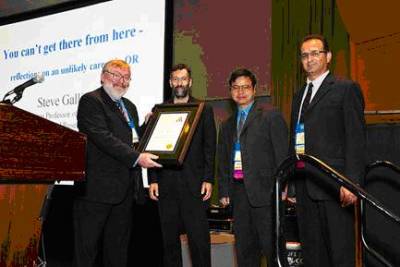 |
| Steve Gallivan (l) accepting the Larnder Award with René Séguin, Liping Fang, and Saeed Zolfaghari |
Steve Gallivan obtained a first class degree in mathematics from University College London (UCL) in 1971. As an undergraduate, he was fascinated by mathematics and was fortunate to secure a job in a work study department of a chain making company to support his studies. This was his first contact with OR. His PhD concerned generalizations of the mathematics underlying linear programming. This work was mostly carried out in UCL with a year as a visiting graduate student at the University of British Columbia. Following this, Steve joined the UK's Transport and Road Research Laboratory, later moving to the Transport Studies Group at UCL. He worked on a variety of problems associated with traffic signal system design and control. This practical work contributed to the development of methods that are used world wide. In 1985, Dr. Gallivan was invited by the famous RRP (Ray) Jackson to join his newly formed Clinical Operational Research Unit (CORU) at UCL. After the initial "culture shock" of learning how to work in close collaboration with clinicians, he grew to thoroughly enjoy this productive and rewarding area of OR. He has worked on projects in a wide range of clinical areas. These include: cardiac surgery, cardiology, cancer, genetic screening, primary health care, mental health, rheumatology, pharmacy, gynaecology, obstetrics, public health, hospital safety, infection control, health service operation.
Dr. Gallivan has co-authored over 200 publications. These have included papers in pure mathematics, transport science and OR journals. He has a substantial number of publications in the medical press, the domain where it has the most impact. There have been many tangible results from his research. Work on cervical cancer screening has been used for evaluating numerous screening options and, more recently, vaccination policies. The modelling of ante-natal genetic screening has been used in an empirical study related to screening for haemoglobinopathies. CORU's hospital capacity modelling has been used in several contexts and is being extended by another research group.
The research for which he is most well known concerns the development of analytical methods for monitoring adverse clinical events, particularly post-operative deaths. CORU developed a monitoring tool known as VLAD that can be used to give a graphical summary of clinical outcomes for a single surgeon or unit. This is adjusted to take due account of the risk profile of cases to avoid penalizing surgeons whose case load is intrinsically complex. Originally developed in the context of adult cardiac surgery at a single centre, the method has been adopted by clinicians within the UK and worldwide. It is in routine use in many cardiac surgery centres, has been extended for use in the context of myocardial infarction and congenital heart surgery. Indeed, a practitioner from Australia has written a book to accompany the method called "VLADs for dummies".
 Close
Close

